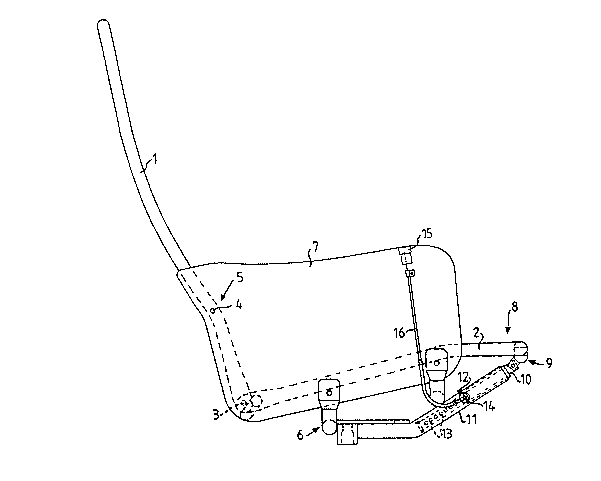Some of the information on this Web page has been provided by external sources. The Government of Canada is not responsible for the accuracy, reliability or currency of the information supplied by external sources. Users wishing to rely upon this information should consult directly with the source of the information. Content provided by external sources is not subject to official languages, privacy and accessibility requirements.
Any discrepancies in the text and image of the Claims and Abstract are due to differing posting times. Text of the Claims and Abstract are posted:
| (12) Patent: | (11) CA 1301043 |
|---|---|
| (21) Application Number: | 1301043 |
| (54) English Title: | ARRANGEMENT IN ADJUSTABLE SEATS |
| (54) French Title: | DISPOSITION DE SIEGES REGLABLES |
| Status: | Expired and beyond the Period of Reversal |
| (51) International Patent Classification (IPC): |
|
|---|---|
| (72) Inventors : |
|
| (73) Owners : |
|
| (71) Applicants : |
|
| (74) Agent: | SMART & BIGGAR LP |
| (74) Associate agent: | |
| (45) Issued: | 1992-05-19 |
| (22) Filed Date: | 1989-01-17 |
| Availability of licence: | N/A |
| Dedicated to the Public: | N/A |
| (25) Language of filing: | English |
| Patent Cooperation Treaty (PCT): | No |
|---|
| (30) Application Priority Data: | ||||||
|---|---|---|---|---|---|---|
|
ABSTRACT
The invention relates to an arrangement in adjustable seats,
in which a back support (1) and seat part (2) are mutually
pivotably (3) joined, and where the back support (1) is
pivotably (4) connected to the rear portions (5) of arm rests
(7) included in the substructures (6) of the seat, and where
the front portion (8) of the seat part (2) is pivotable in at
least one pivot point (9) on the underside of the seat part
(2), from which extends at least one slide bar (10) in the
longitudinal direction of the seat part for coaction with a
fixed locking sleeve (11) projecting out from the lower part
of the substructure (6) for enabling an adjustment desired by
the user of the mutual, angular positions of the back support
(1) and seat part (2). The slide bar (10) is telescopically
displaceable in its longitudinal direction, and fixable in at
least two predetermined, distinct locking positions in the
locking sleeve (11) projecting from the substructure (6),
said sleeve having at least one hole (12) through its
surface, and through said hole at least one locking pin (14)
can be thrust for coaction with a bore (13) in said bar when
said hole is in register with said bore, for mutually locking
the bar and sleeve.
(Fig. 1)
Note: Claims are shown in the official language in which they were submitted.
Note: Descriptions are shown in the official language in which they were submitted.

2024-08-01:As part of the Next Generation Patents (NGP) transition, the Canadian Patents Database (CPD) now contains a more detailed Event History, which replicates the Event Log of our new back-office solution.
Please note that "Inactive:" events refers to events no longer in use in our new back-office solution.
For a clearer understanding of the status of the application/patent presented on this page, the site Disclaimer , as well as the definitions for Patent , Event History , Maintenance Fee and Payment History should be consulted.
| Description | Date |
|---|---|
| Time Limit for Reversal Expired | 2008-05-20 |
| Letter Sent | 2007-05-22 |
| Grant by Issuance | 1992-05-19 |
There is no abandonment history.
| Fee Type | Anniversary Year | Due Date | Paid Date |
|---|---|---|---|
| MF (category 1, 6th anniv.) - standard | 1998-05-19 | 1998-05-13 | |
| MF (category 1, 7th anniv.) - standard | 1999-05-19 | 1999-04-26 | |
| MF (category 1, 8th anniv.) - standard | 2000-05-19 | 2000-05-12 | |
| MF (category 1, 9th anniv.) - standard | 2001-05-22 | 2001-05-10 | |
| MF (category 1, 10th anniv.) - standard | 2002-05-21 | 2002-05-06 | |
| MF (category 1, 11th anniv.) - standard | 2003-05-20 | 2003-05-09 | |
| MF (category 1, 12th anniv.) - standard | 2004-05-19 | 2004-05-07 | |
| MF (category 1, 13th anniv.) - standard | 2005-05-19 | 2005-04-26 | |
| MF (category 1, 14th anniv.) - standard | 2006-05-19 | 2006-05-09 |
Note: Records showing the ownership history in alphabetical order.
| Current Owners on Record |
|---|
| MOBELTEAM AB |
| Past Owners on Record |
|---|
| AKE LINDEN |
| ROGER GUSTAFSSON |